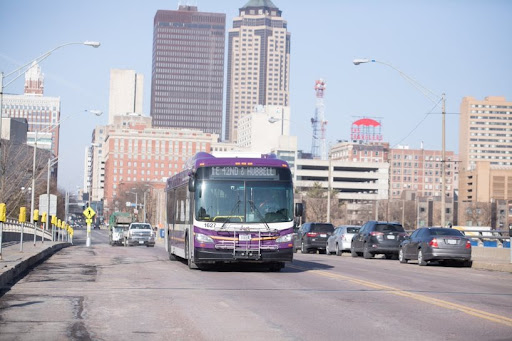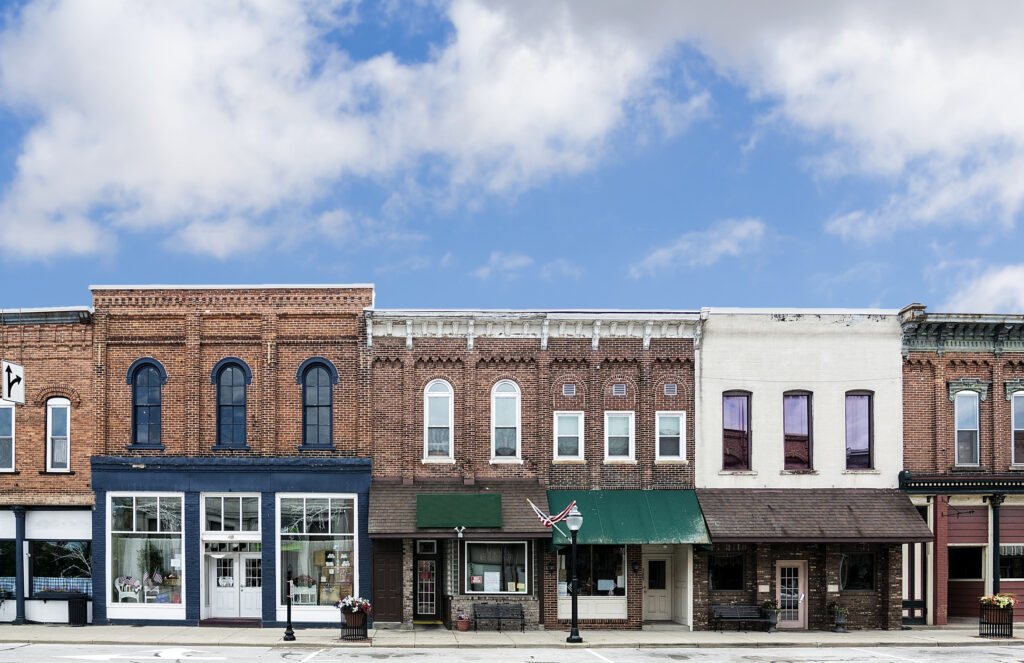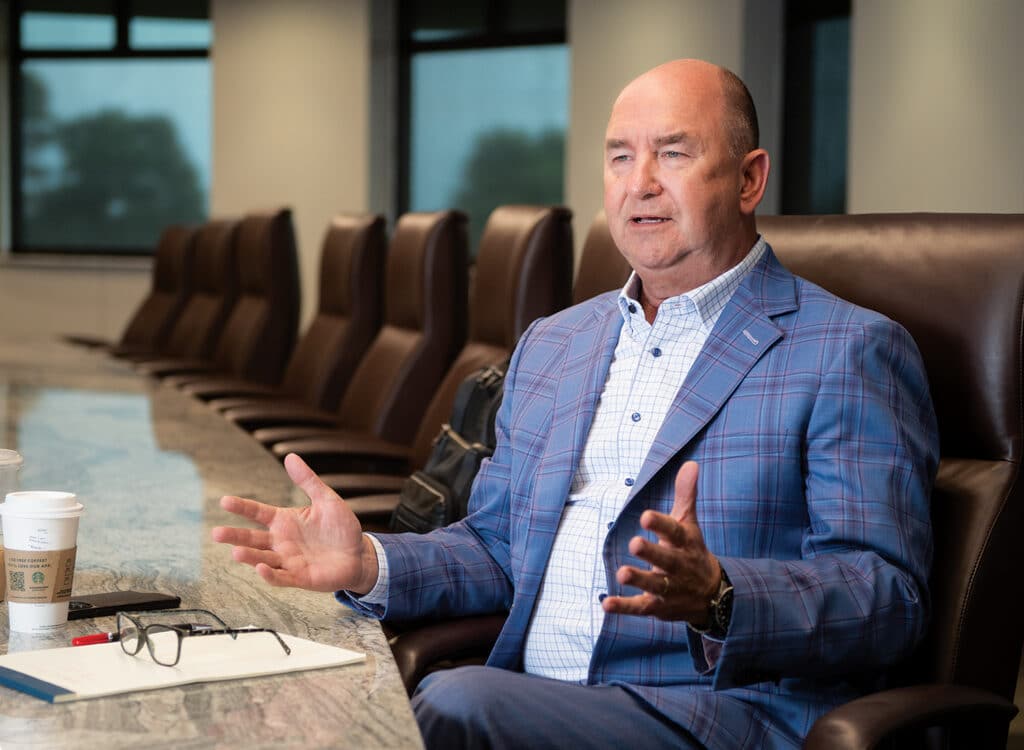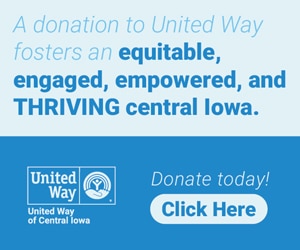DART considers alternative transit models as it looks to better meet community’s changing needs

A DART bus travels east away from downtown with the Des Moines skyline in the background. The transit agency is seeking public input on proposals to improve its service with recommendations going before the agency’s commission for possible approval in December. Photo courtesy of DART
The Des Moines Area Regional Transit Authority will begin seeking public input this week on proposals for its future as the agency considers how it can best serve the community and its evolving needs.
The Business Record sat down recently with Luis Montoya, the chief planning officer for the agency that serves 11 member communities and Polk County, and Chief External Affairs Officer Erin Hockman to learn more about the proposals and what DART has planned as it reaches out to engage with the community about the proposals.
What’s important to consider is who rides DART, the reasons they ride DART, where the busiest routes are, where more service may be needed and areas where the agency can possibly transition to alternative, more cost-effective methods of providing service.
The numbers
DART had a daily ridership before the pandemic of nearly 15,000, with annual ridership of about 4.4 million. While the numbers dropped off in the early months of the pandemic, they have begun to recover.
Thirty-seven percent of DART riders are 34 years old or under; 42% don’t own a working vehicle; 58% have an annual household income of less than $25,000; 61% of DART riders are white while 27% are Black, indicating a disproportionate number of Black residents ride DART compared to their population in the state (4.1% in 2021). Forty-three percent of DART riders use the bus to go to work, while 16% use it for health and medical reasons, and 13% ride DART to shop.
According to data provided by DART, two-thirds of its riders are on its nine most frequent and productive routes, and shuttle and express routes have lost ridership in the past decade.
Work to develop the proposals began in early 2020, but was put on hold in the early days of the coronavirus pandemic. It resumed earlier this year and an early round of public input was conducted last spring. Now, recommendations have been developed and will be shared with the public. A final report is expected to be finalized in November, with it going to the DART commission for approval in December.
Adapting to change
As part of the analysis, DART officials are evaluating which routes are the most productive and which routes are the least productive.
“When we think about where we want to make adjustments, we actually look at the performance of each individual route and do we need to provide more or less service because it’s not being efficient at the current level of service” Montoya said.
A big challenge is the continued trend of development away from the city’s center and toward the suburbs.
Montoya said areas that are developed outside of existing bus routes are more difficult and expensive to serve.
“The growth is expected to continue in our region, and it’s hard not only for DART to have really long bus lines that go out and serve the edge of a growing community, but as we look at the travel patterns, people don’t just travel in straight lines. Increasingly, they are dispersed all over the place.”
Hockman said DART’s model has evolved since the agency was first developed. It was initially developed to bring commuters to downtown, where a lot of the area’s biggest employers are, but it has evolved as the community has grown, she said.
“While we have continued to adjust and tweak the service, it was really developed as a hub-and-spoke system so there was a lot of service coming in and out of downtown,” Hockman said.
That change is really at the hub of the agency’s pursuit of changes to better and more efficiently serve the region, which is continually evolving and as people’s work patterns and lifestyles change.
Some of the changes contained in the proposal include using small microtransit vehicles more frequently to better meet the needs of riders in a certain area. In some cases, DART may contract with a ride service, such as Uber or Lyft, to pick up a rider and deliver them to a hub where they can get on a bus to take them to their destination. Things like bike share and scooter programs could also be considered to improve access to transit, Montoya said.
The recommendations include “Near-Term Service Proposals,” that would address underperforming bus routes and repurpose resources to improve service to customers within a cost-neutral framework.
One example is a pilot project in Ankeny, which takes the Ankeny On-Call service, which operates limited hours five days a week and requires a rider to schedule it a day ahead of time. Under the proposal, its hours would be expanded and it would operate it like Uber or Lyft, where someone would call and a DART driver in a smaller DART vehicle would be dispatched to pick up that rider.
“We see that as really being a game-changer in making it more convenient for people to ride in that they don’t have to book it a day ahead of time, but then also be able to expand those hours that people can rely on to get to work,” Montoya said.
Expanding the hours would also open opportunities for riders to connect with other routes to get elsewhere in the metro, he said.
A similar model is proposed in West Des Moines, along University Avenue and 60th Street to Jordan Creek Parkway.
“The whole other area where we have much less ridership … we think could be better served by that microtransit so where people have the flexibility, they don’t have to come out on a set time and set schedule, they could schedule those trips … ahead of time if they wanted to, but they could also schedule in real time and have a bus take them anywhere within the zone,” Montoya said.
Another alternative service model builds off a pilot that was done in 2019, called Flex Connect. It is a partnership with Uber and Yellow Cab to get people to a bus stop. It would replace Route 74 in West Des Moines, which currently operates as a shuttle from Valley West Mall to business parks and employers in Urbandale. Ridership on that route has waned in recent years, and Montoya said an alternative service model could allow DART to serve those riders more cost effectively.
“When you think about that growth that’s happening in the Urban Loop around Interstate 80/35, we really saw an opportunity as much to address the underperforming bus route as to expand service up there,” he said.
That route currently operates a set schedule in the peak morning and evening hours, “but for the same cost, we can offer them an Uber or Yellow Cab throughout the day, so now they have flexibility,” he said.
During an earlier pilot, those rides were offered at no cost, but moving forward the cost would be similar to a bus fare, Montoya said.
“We do need to work out details but … it would be subsidized by DART, recognizing it would be more cost-effective than to run a full-size bus with a driver because you’re only running it when people need it, not throughout the day,” he said.
That model, like the others, would be a cost-neutral operation, Montoya said.
Hockman said the proposals show DART’s commitment to serve riders in the best, most efficient way possible.
“This is a good example of where we are demonstrating when there’s high-ridership, it makes sense to operate and invest in those fixed routes services, where there is a need for travel, but it’s not as great or the overall demand, there’s other more flexible services that can meet those needs at a different cost,” she said.
The last Near-Term Proposal addresses routes to Altoona and Bondurant. Route 17 was expanded last year to the new Amazon facility in Bondurant, but only goes along Adventureland Drive to Bondurant four times a day. That would increase under the proposal.
“We have Route 99 that was declining before the pandemic … so we would use resources from Route 99 and extend more trips on Route 17 to have it run every hour on that piece from Altoona to Bondurant,” Montoya said. “We would be repurposing it from an area that is underutilized to an area we think has a lot of promise.”
Long-term goals would be continuing and expanding mobile-on-demand and microtransit services, improving weekend services, and identifying cross-town routes that connect high-activity areas and don’t come downtown. Reducing travel times and wait times are also on the long-term list of proposed improvements.
What do you think?
All details of the proposals will be included in an interactive website, which went live this week. There will also be public meetings, open houses, community events, ride-alongs and focus groups over the next couple of months to get public input.
Hockman said the overall goal is to ensure that everyone in the region has access to transit services.
“As we think about all the issues the region is tackling as we grow, growth in jobs, getting people to work, equity, it’s important to make sure our region is accessible and a place where people want to live and they can get around,” she said. “Transit isn’t what people may have thought of it anymore because of technology and the way it’s changing. There’s a lot of different ways to meet mobility needs that fit that demand. There’s a lot of innovative ways to meet the needs of the region.”









